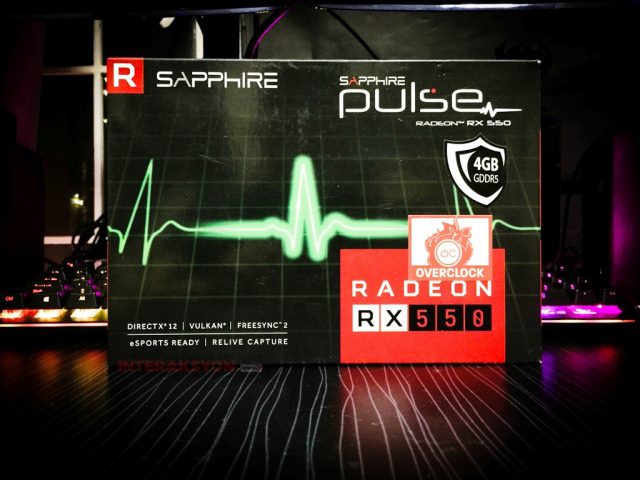PC gamers nowadays will not settle for 30 fps in playing competitive eSports games because everybody needs the gameplay to be fluid and without stutter so that they can take that winning shot. But just because you are on a tight budget doesn’t mean that you have to settle for less. That is where the AMD Radeon RX 550 comes in because it promises to deliver smooth and stutter free 1080p gaming from your favorite eSports titles, without going beyond US$100.

Appearance
They say that size doesn’t matter. Even though the Sapphire Pulse RX 550 is a single slot small form factor graphics card, it’s edgy minimalist design definitely says a lot about what it can deliver.
It has a single fan right on top of the heatsink with a neat-looking pulse design running across the plastic. We really like the wedged design on the black colored shroud with the red lines which gives a nice touch to the overall look of the unit.
Given by its size, this graphics card does not require extra power cables and it is completely powered by the motherboard’s PCIe slot, consuming a typical board power requirement of 50w. Yet, despite the low power consumption, we still recommended the use a 400w PSU. For display connections, it has one DisplayPort 1.4, one HDMI and one DVI port.
Features
Given the entry-level nature of this graphics card, it packs an impressive set of features that gives it an edge to what it is meant to do. It supports FreeSync Technology, making it a perfect match to any budget friendly FreeSync enabled display monitors to deliver buttery smooth visuals in video games and it’s optimized for DirectX 12.
It also supports AMD Eyefinity, which lets you use up to 3 displays at once for a more immersive gaming experience. It also supports AMD XConnect so you can use it as an external GPU for laptops by using an external dock. Finally, it can utilize Radeon Chill, as well as the full suite of Radeon ReLive software and AMD Link mobile app.

Specifications
GPU
512 Stream Processors
14 nm FinFET
4th Graphics Core Next (GCN)
1206 MHz Boost Engine Clock
Memory
128 bit Memory Bus
GDDR5 Memory Type
1500 MHz, 6000 MHz Effective
4 GB Size
Resolution
5120×2880 (60Hz) Pixel DisplayPort Resolution
2560×1600 (60Hz) Pixel Dual Link DVI Resolution
4096×2160 (60 Hz) HDMI Resolution
API
OpenGL 4.5
OpenCL 2.0
DirectX 12
Shader Model 5.0
Testing rig
For the benchmark test we will be using own own rig which will definitely bring out the performance of this entry-level GPU while using the latest Radeon driver to date. We will compare it with the closest GPU in its class, the Nvidia GT 1030. Here are my hardware specs:
CPU – Ryzen 5 1600
Motherboard – Asus Crosshair VI Hero X370
RAM – Geil Evo X 2x8GB @ 3200Mhz DDR4
Sapphire Pulse RX 550 4GB
MSI GT 1030 2GB
Benchmarking
What we showed here is a series of results from different applications that will help us have an idea what kind of performance can the RX 550 give when it comes to a variety of GPU tests, which include both synthetic benchmarks, productivity, and gaming.
Do take note that this GPU is simply not intended to play high-end AAA games like other graphics cards and this is merely designed as a step-up from integrated graphics solutions. To be honest though, we were quite surprised on how it fared with some of our eSports games.
First up we have 3D Mark’s Time Spy, a DX12 specific benchmark, and it gave our RX550 a GPU score of 1140 points while the GT 1030 scored 1083 points
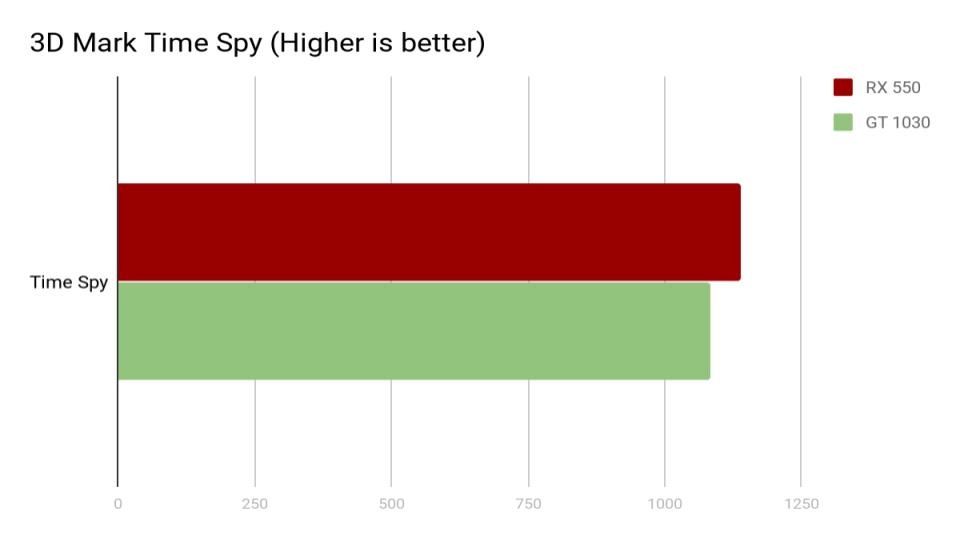
Next, another 3D Mark benchmark, Fire Strike. This time it gave our card a GPU score of 4320 while the GT 1030 scored 3663.
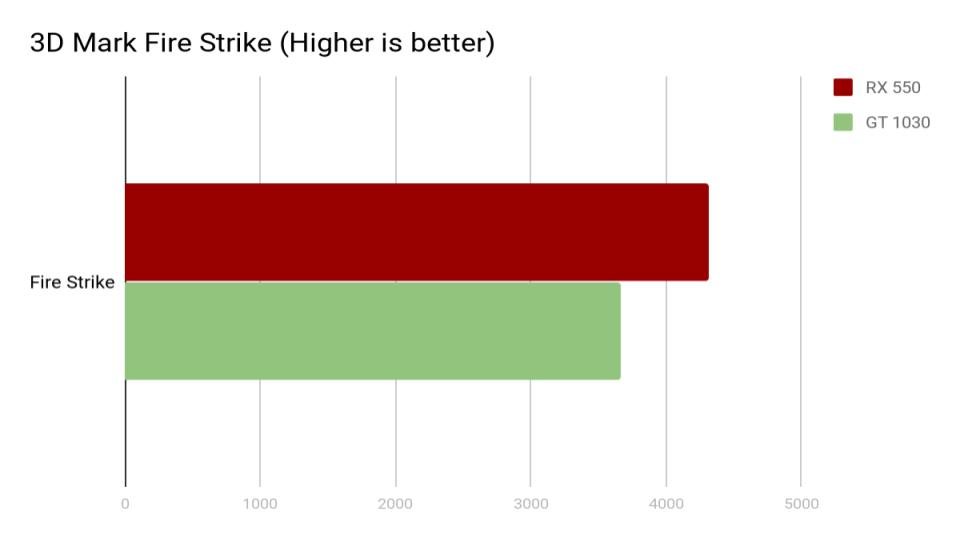
Then we also ran Unigine Heaven benchmark and it gave us a total score of 626 points while the GT 1030 receives 545 points.
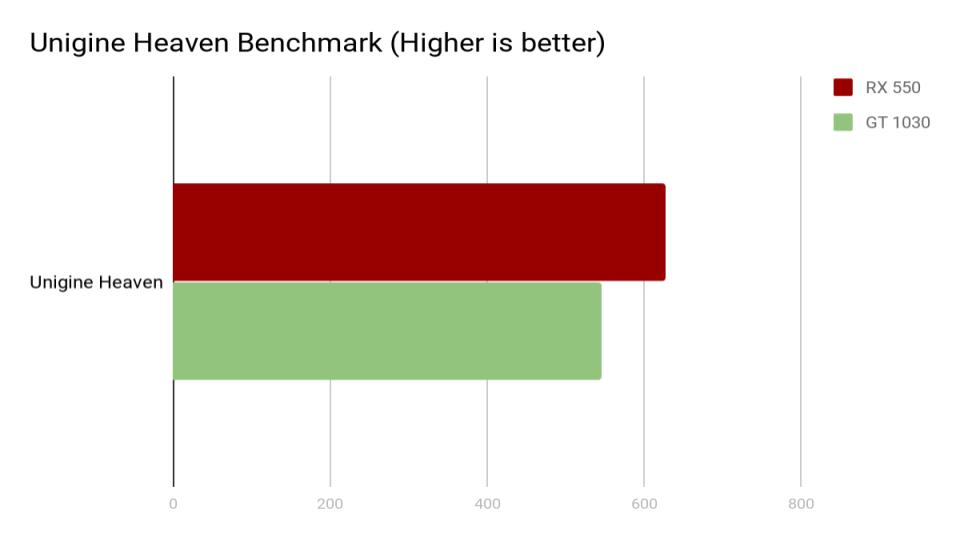
For productivity rendering test, we chose to use Blender, an open source 3D Computer Graphics software. We ran it with the BMW Blenchmark test file and the BMW model took exactly 00:03:08 (three minutes and eight seconds) to render while the GT 1030 took the lead in rendering for only 00:02:35 (two minutes and thirty five seconds). The CUDA rendering of the Nvidia card had more advantage here more than the OPENCL rendering of the Radeon card.
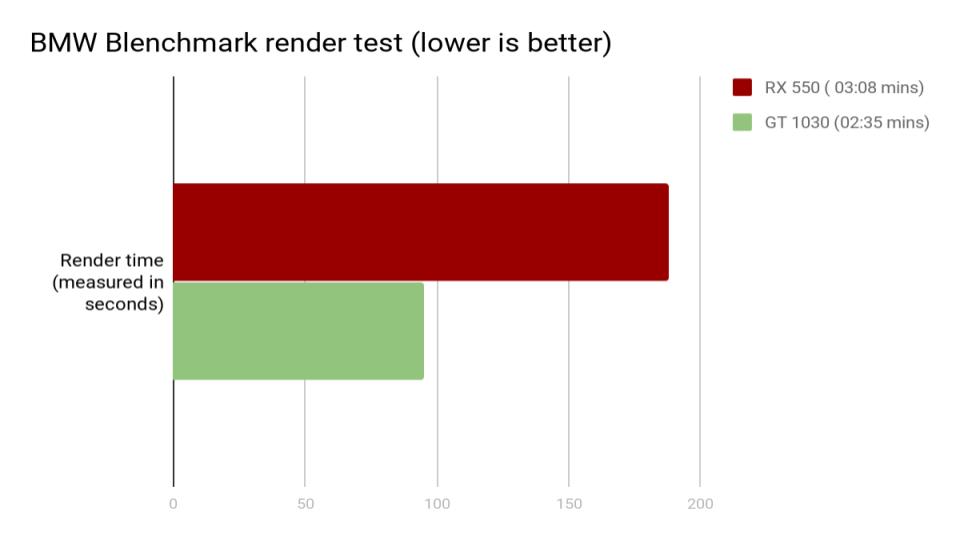
Now, for the gaming tests. we ran all games at the most playable settings in 1080p resolution and as you will see, we had a mix of eSports titles as well as some high-end AAA games.
First up, we have Counter Strike: Global Offensive, all on high settings with FXAA turned on. The RX 550 gave us an average of 122 frames per second in a whole Ranked Competitive match while the GT 1030 had an average of 118 frames per second.
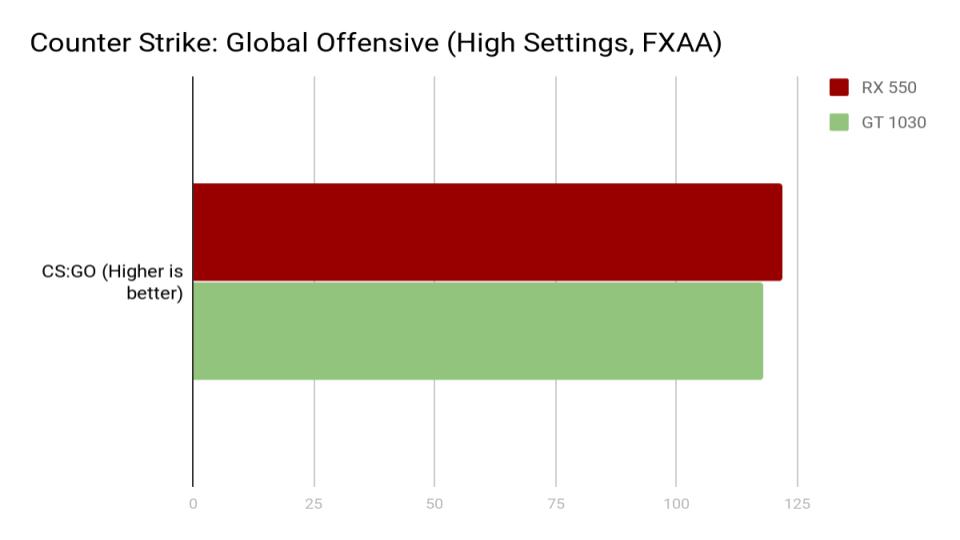
Next up is DOTA 2 on the Medium graphical preset and it gave us an average of 180 frames per second in a casual match that lasted around 40 minutes while the GT 1030 scored an average of 172 frames per second.
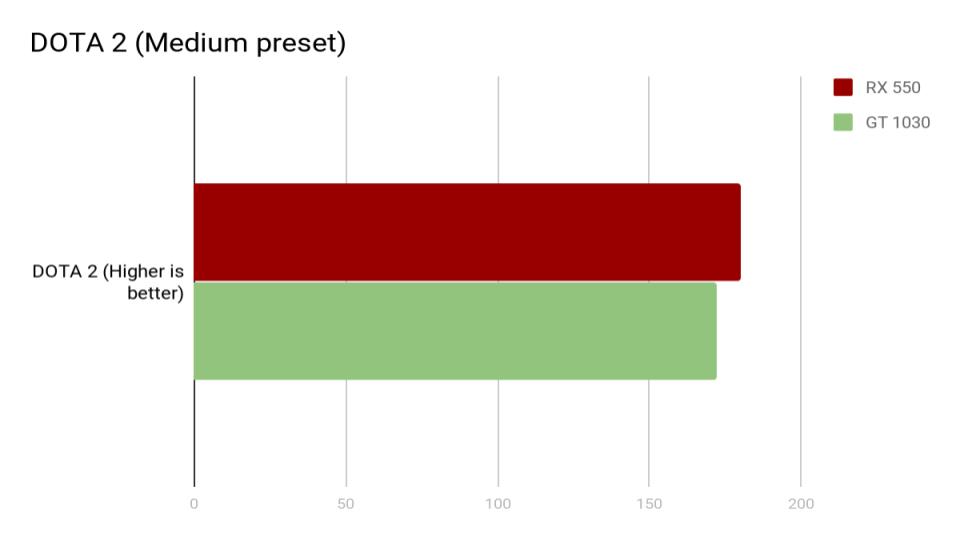
The next game is another rising star in the eSports scene and is something a little bit heavier on the graphics side, Tom Clancy’s Rainbow 6 Siege, played on the Medium graphical preset on a whole casual multiplayer match. The RX 550 gave us an average of 63 frames per second. On the other hand, the GT 1030 performed better and gave us an average of 83 frames per second.
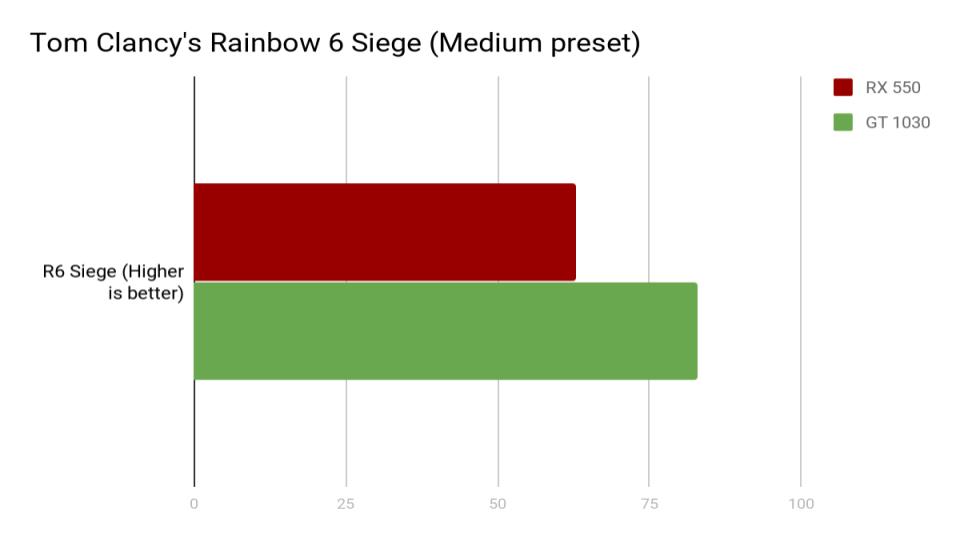
The last 3 Games that we ran the test on are all higher-end AAA games that we were only able to play on the lowest preset possible on 1080p to make them playable. If we reduced the screen resolution to 720p, we’re sure we’ll be able to get better frame rates. So with that, the following games are Sniper Elite 4, Playerunknown’s Battlegrounds, and Tom Clancy’s Ghost Recon: Wildlands.
As you can see, on Sniper Elite 4, we were only able to get an average of 43 fps. On PUBG, we were only able to have an average of 36 fps, and lastly on Ghost Recon: Wildlands, we were only able to achieve an average of 40 fps. While on the GT 1030, we were able to achieve 46 fps, 48 fps, and 35 fps, respectively.
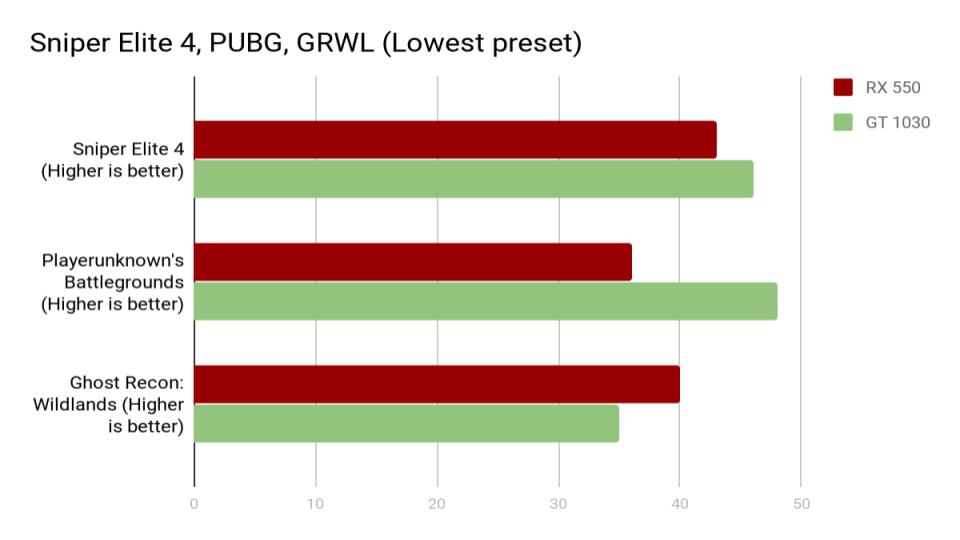
The gameplay on all those titles were not that bad. Some games performed better on the Nvidia card compared to the RX 550 but the latter definitely has a better graphical output because of it’s 4GB of VRAM.
Conclusion
So what’s the verdict for this graphics card? Being priced at Php5,320 (based on PCHub price as of 20/02/2018), We don’t think it meets the balance between price and performance. And I’m being honest here.
The performance of the RX 550 does not justify being more expensive than other graphics cards in its class given that for a bit more money, the cheapest GTX 1050 2GB which is around Php6,970 (based on PCHub price as of 20/02/2018), will give more performance by a significant margin. But if you don’t mind not having to spend more than what the RX 550 costs, then you will find this card to be more than satisfactory with regard to gaming, productivity, and even for watching 4k videos.
The small form factor of this card makes it ideal for simple home theatre PCs that can be as good as gaming consoles or even as a 4k resolution Netflix streaming box.
Nonetheless, the RX 550 delivers to it’s promise that allows eSports gamers to experience their games above 60 frames per second in 1080p resolution.


